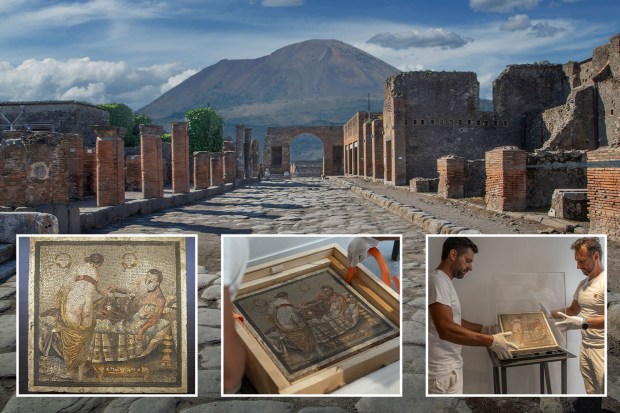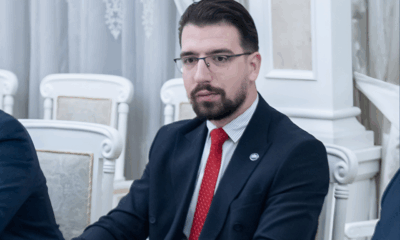Science
Ancient Mosaic Stolen by Nazis Returned to Pompeii After 80 Years

Ancient erotic art stolen from Pompeii over 80 years ago has been officially returned to Italy, as announced by the nation’s cultural heritage police. This 2,000-year-old mosaic, featuring a half-naked couple, was taken during World War II by a Nazi officer.
The mosaic, which depicts a man reclining in bed with a female partner standing in front of him, provides a glimpse into the themes of domestic intimacy that began to emerge in ancient Roman art. It was recovered following diplomatic negotiations between Italy and Germany and is set to be displayed in Pompeii, alongside numerous other archaeological treasures.
The piece was originally stolen from the vicinity of Pompeii, located near Naples, by a German army captain tasked with military logistics in Italy. After taking the mosaic, the officer gifted it to a civilian, who retained it until his death. His heirs subsequently contacted Italian authorities to facilitate the artwork’s return upon realizing its true origin.
Gabriel Zuchtriegel, the German-born director of the Pompeii archaeological park, remarked on the cultural significance of the mosaic. He noted that while earlier Roman art predominantly focused on heroic myths and deities, this piece reflects a shift towards more relatable themes of love and intimacy. Zuchtriegel pointed out the male figure’s expression, indicating a sense of ennui, which adds depth to the portrayal of domestic life.
The mosaic is set on a slab of travertine and is dated to between the late 1st century B.C. and the 1st century A.D.. It will join hundreds of other artifacts in Pompeii, a city that was buried by the eruption of Mount Vesuvius in 79 A.D. The eruption preserved many aspects of Roman life, including a wealth of sexually explicit artworks that have been documented in the ruins.
Pompeii’s history is marked by the catastrophic volcanic eruption that led to its burial under layers of ash. The thermal energy released was significantly greater than that of the nuclear blasts at Hiroshima and Nagasaki. The site was lost for nearly 1,500 years until its rediscovery in the late 16th century, followed by extensive excavations in the 18th and 19th centuries.
Many artifacts recovered from Pompeii, including the mosaic, highlight the city’s vibrant culture, which included a well-documented affinity for brothels, alcohol, and explicit art. Hundreds of such works are housed in the Secret Museum at the National Archaeological Museum in Naples. This collection includes phallic statuary and graphic depictions believed to have served as advertisements for local establishments.
In the early 19th century, the explicit nature of some pieces led to the closure of certain museum areas, which remained restricted until their reopening in 2000. The ongoing excavations continue to yield significant findings, shedding light on the lives of those who once inhabited this ancient city.
As the mosaic returns to its rightful home, it serves as a reminder of the rich and complex tapestry of Roman life that was so suddenly interrupted by disaster. The story of this artwork, from its theft during a tumultuous period to its eventual repatriation, reflects the enduring significance of cultural heritage and the efforts made to restore it.
-

 Entertainment3 months ago
Entertainment3 months agoAnn Ming Reflects on ITV’s ‘I Fought the Law’ Drama
-

 Entertainment4 months ago
Entertainment4 months agoKate Garraway Sells £2 Million Home Amid Financial Struggles
-

 Health3 months ago
Health3 months agoKatie Price Faces New Health Concerns After Cancer Symptoms Resurface
-

 Entertainment3 months ago
Entertainment3 months agoCoronation Street’s Carl Webster Faces Trouble with New Affairs
-

 Entertainment2 months ago
Entertainment2 months agoWhere is Tinder Swindler Simon Leviev? Latest Updates Revealed
-

 Entertainment4 months ago
Entertainment4 months agoMarkiplier Addresses AI Controversy During Livestream Response
-

 Science1 month ago
Science1 month agoBrian Cox Addresses Claims of Alien Probe in 3I/ATLAS Discovery
-

 Entertainment4 months ago
Entertainment4 months agoKim Cattrall Posts Cryptic Message After HBO’s Sequel Cancellation
-

 Entertainment2 months ago
Entertainment2 months agoOlivia Attwood Opens Up About Fallout with Former Best Friend
-

 Entertainment3 months ago
Entertainment3 months agoMasterChef Faces Turmoil as Tom Kerridge Withdraws from Hosting Role
-

 Entertainment4 months ago
Entertainment4 months agoSpeculation Surrounds Home and Away as Cast Departures Mount
-

 World2 months ago
World2 months agoCole Palmer’s Mysterious Message to Kobbie Mainoo Sparks Speculation




















